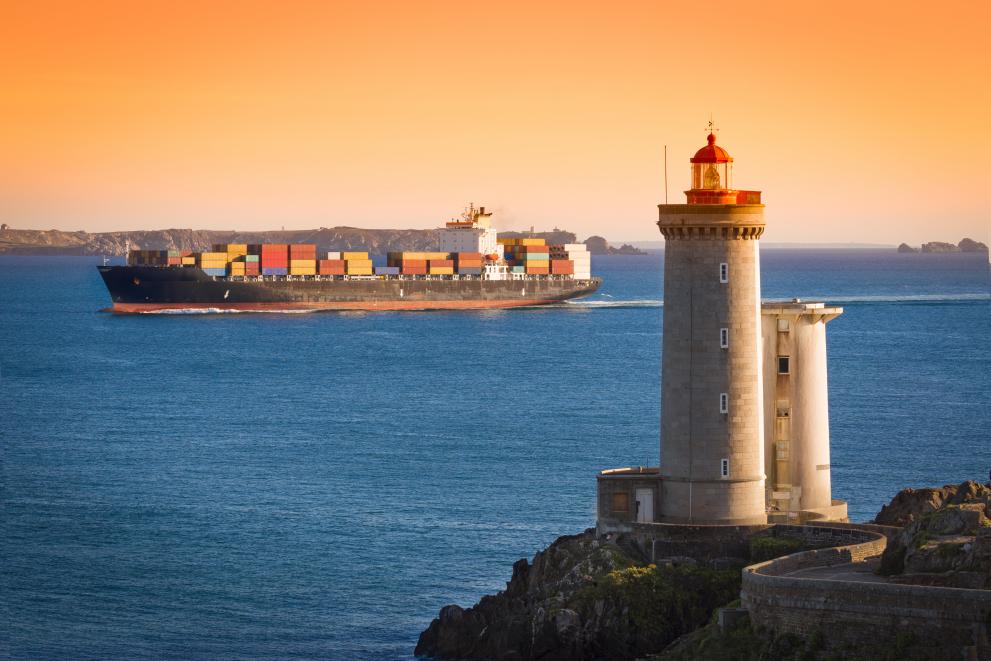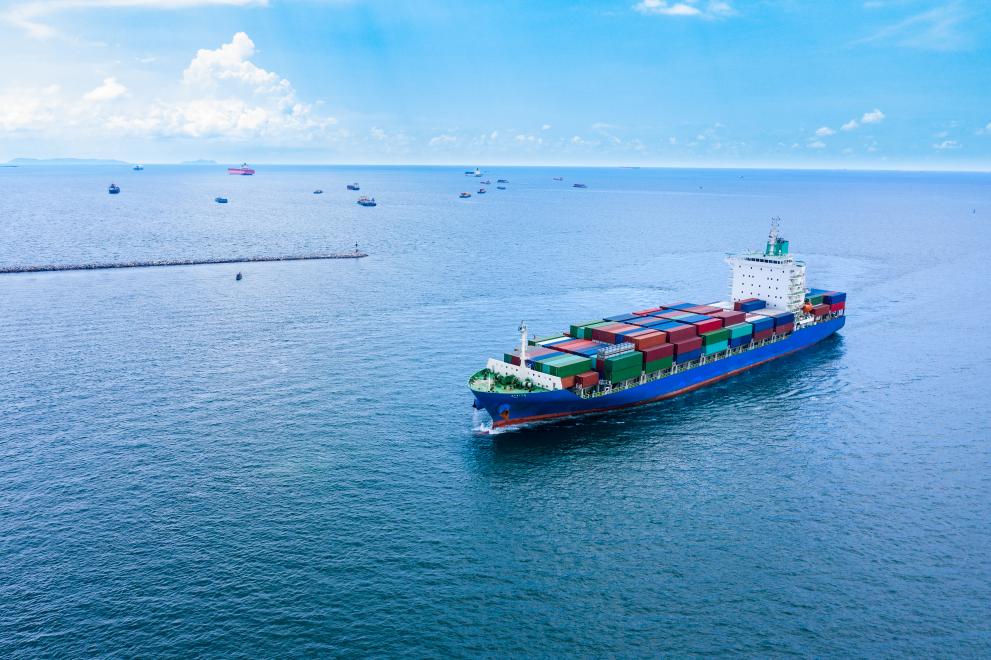
The European Union is the world’s biggest trading block. Although it contains just 5% of the world’s population, it contributes 14.9% of global GDP (2020). In 2021, about 1.6 billion metric tonnes of goods were loaded in Europe, and about 1.7 billion were discharged. These account for roughly 14% and 16% of the world’s seaborne trad. On a year-to-year basis, the European trade increased the loaded cargo by 2% and the discharged cargo by 5%, recovering from the impact of the COVID-19 pandemic; however, the volumes are still 2% and 12% lower than in 2019. The top-three EU partner countries are Russia, USA and China.
The EU fleet is large and quite heterogeneous. The ships registered under the flag of an EU Member State represented 16.2% of the total world fleet measured in dead weight tonnage (DWT). In terms of absolute numbers, the EU Member State-flagged fleet contains nearly 40% of the world’s RoPax fleet (vessels that can carry cars and passengers), 33% of all cruise vessels, 29% of passenger ships and 20% of container ships.

Maritime transport includes:
- passenger transport: sea, coastal and inland passenger water transport;
- freight transport: sea, coastal freight and inland freight water transport;
- services for transport: renting and leasing water transport equipment.
Inland transport is considered part of the Blue Economy because it includes the transportation of passengers and freight via rivers, canals, lakes and other inland waterways, including within harbours and ports.
Overall, maritime transport accounted for 22.9% of the jobs, 31% of the GVA and 37% of the profits in the EU Blue Economy in 2020. Freight transport accounted for 54% of value added across the Member States, service for transport for 37%,and passenger transport for the remaining 9%.

The maritime transport sector generated a GVA of EUR 29.5 billion in 2020, a decline of 14% compared to the 2019 peak. Gross profit, at EUR 14.7 billion, decreased by 15% on a year-to-year basis. The profit margin was estimated at 10%, slightly below the 11% recorded in 2019. The investment ratio (gross investment in tangible goods / GVA) was estimated at 41%, recording a sharp increase in 2019. The turnover reported was EUR 147.4 billion, a 9% decrease from 2019.
In 2020, about 371 600 people were employed in the sector, half of which within services for transport, a quarter within passenger transport, and the remaining quarter within freight transport. The total salaries amounted to EUR 14.9 billion, and the annual average wage was estimated at EUR 40 000, up 2% compared to 2019.
The Member State that contributed the most to the EU GVA within the sector is Germany (34%), followed by Denmark (26%) and Italy (9%). Most of the workforce (about 125 000, equivalent to about 34%) was employed in Germany, followed by Italy (62 000, equivalent to 17%) and France (38 000, equivalent to 10%).
Like most sectors of the economy, maritime transport has been hit by the COVID-19 pandemic. As a result, the United Nations Conference on Trade and Development (UNCTAD) reported that the volume of imports and exports in Europe in 2020 diminished by 7.3% and 7.8%, compared to the previous year. However, in 2021, there was a rebound (8.3% and 7.9% on the previous year) due to the gradual reopening of economies.
Activities connected to freight transport were not, however, the ones hit the hardest due to the pandemic. Other economic activities of the sector suffered more, such as passenger transport, which was suspended in Europe in March 2020. In that period indeed, many countries implemented travel restrictions and lockdown measures to curb the spread of the virus, with harsh consequences on its economy.
The importance of maritime logistics for trade purposes has become very evident in 2022 due to the Russian invasion of Ukraine. With a reduced maritime connectivity and higher shipping costs, the inflation rose, so as shortages of food. This opens new trade scenarios for countries that try to substitute the supplier (e.g. Ukraine) that is unable to meet the demand. Looking ahead, the impact of the war impact on container shipping is likely to exacerbate due to a halt to the global economic growth and to reductions to consumer spending power. It will also increase oil prices, inflation, and the cost of living, and add economic and investor uncertainty.
Technological advancement, such as artificial intelligence, digitalisation and automation may rapidly change the way traditional maritime transport works and operates and can drive the growth of the sector. Development of (fully or partly) autonomous ships will pose both opportunities and challenges for the sector in terms of safety, security, existing legal frameworks, and operations. The Maritime Autonomous Surface Ships (MASS) have the potential to increase safety and productivity as well as to contribute towards the sustainability goals for maritime transport . Currently, autonomous and remote-controlled ships are being trialled in some sea areas and are expected to travel short distances in the near future.
Maritime transport remains an important pillar of the Blue Economy, playing a key role in the world’s economy and towards the achievement of EU decarbonisation objectives. Due to the expected growth of the world economy and associated transport demand from world trade, greenhouse gas emissions are projected to increase to 90-130% of 2008 emissions by 2050 for a range of plausible long-term economic and energy scenarios, according to the International Maritime Organization (IMO). These figures clash with the goal of climate neutrality, which requires a 90% reduction in transport emissions by 2050. Hence, more and cleaner transport alternatives are needed.
The European Commission outlines and revises environmental regulations and strategies to achieve the target of climate neutrality. The Sustainable and Smart Mobility Strategy sets out a path towards achieving the objectives of sustainable, smart and resilient mobility. The first important milestone is that zero-emission vessels will become ready for market by 2030. The FuelEU Maritime proposal outlines a framework to increase the share of renewable and low-carbon fuels in the fuel mix of international maritime transport, which currently relies entirely on fossil fuels.
The Commission also adopted an ambitious strategy for European transport under the umbrella of the European Green Deal. This new strategy is based on sustainability, built on multimodal transport systems (for both passengers and freight) enhanced recharging and refuelling infrastructure for zero emission vehicles, (including ships, boats, and ferries), and digitalisation and the use of new technologies. Delivering the establishment of wide-ranging ‘Emission Control Areas’ (ECAs) in all EU waters with zero pollution to air and water from shipping for the benefit of sea basins, coastal areas, and ports will be a priority. In particular, the Commission has spearheaded efforts to replicate the success of existing ECAs in areas of the Mediterranean Sea that require urgent protection. By 2030, such measures could cut emissions of SO2 and NOx from international shipping by 80% and 20%, compared to the current regulations. Similar efforts will also be made in the Black Sea region, where development is required.
Underwater noise from shipping is also increasingly recognised as a significant and pervasive pollutant, affecting marine ecosystems on a global scale. There is also documented scientific evidence linking noise exposure to a range of harmful effects on marine mammals, sea turtles, fish, and invertebrates. The impact affects species that are at serious risk of extinction, which are commercially important, and critical for supporting ecosystems. Under the marine strategy framework directive, EU experts have recently adopted recommendations on threshold values defining where and for how long marine habitats can be exposed to continuous underwater noise from shipping. To respect these limits, Member States have the responsibility to implement appropriate measures in their marine strategies, for example, by reducing ship-generated noise or setting spatial restrictions for human activity. At a global level, this also feeds ongoing discussions under the IMO to reduce the levels of underwater noise from shipping.

![[Cargo vessel in the sea]](/sites/default/files/styles/embed_large/public/2022-04/AdobeStock_490522696.jpeg?itok=8fJE2u3I)